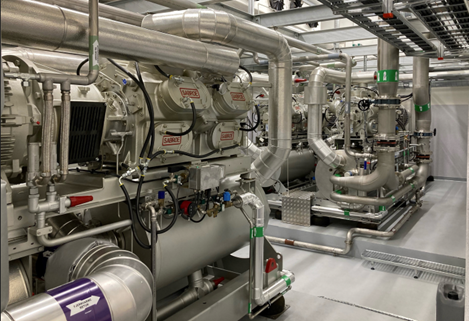HOFOR (Greater Copenhagen Utility) supplies district heating (DH) to app. 670,000 customers in Copenhagen. HOFOR wants to have a competitive and CO2-neutral DH supply. Novozymes is the global market leader in biological solutions, producing a wide range of industrial enzymes and microorganisms.
In 2019 HOFOR and Novozymes initiated a cooperation about utilizing Novozymes’ excess heat in the HOFORs district heating network. Both companies have a green strategy where energy efficiency is part of the efforts to reduce the companies’ CO2-emission.
The cooperation resulted in the planning and installation of a heat pump, with a heat production capacity of 4 MW, that started operation by the end of 2020. The heat pump uses excess heat from Novozymes’ enzyme production and supplies about 6,000 local citizens in Copenhagen with district heating. The heat pump has reduced HOFORs use of natural gas, oil, and biomass for DH production, and contributed to a more diverse energy- and technology mix. Furthermore, the heat pump has reduced the consumption of water and electricity in Novozymes’ cooling towers because the heat pump produces cooling to Novozymes while heating to HOFORs DH network.

On an annual basis, the heat pump utilizes app. 22,000 MWh excess heat from Novozymes’ production. The use of electricity in the heat pump is app. 8,000 MWh and the DH production is app. 30,000 MWh corresponding to a coefficient of performance (COP) of app. 3.8.
The heat pump helps HOFOR and Novozymes to increase energy efficiency and to reduce CO2 emissions. Since the heat pump uses electricity as input, which in Denmark is increasingly produced by wind turbines, the heat pump also supports sector coupling between the electricity and heat sectors. By having different DH production technologies available, including both CHP plants and heat pumps, HOFOR can switch between heat production technologies depending on the electricity price. When electricity prices are high, HOFOR can produce heat at a CHP plant and thereby produce electricity at the same time. When electricity prices are low, HOFOR can produce heat at heat pumps and thereby consume electricity at the same time. This switch between producing or consuming electricity depending on the electricity price helps to minimize the costs of heat production. Furthermore, it supports the integration of even more wind power and solar PV in the electricity system since there is a correlation between much wind power / solar PV and low electricity prices. Therefore, the project is very important for HOFOR to get experience in operating heat pumps in the DH system.
HOFOR and Novozymes are constantly focusing on how to further optimize the operation of the heat pump considering both the requirements for cooling at Novozymes’ production site, the requirements in the DH network (including temperature requirements), the current heat demand, the production at other DH production facilities, and the wholesale electricity prices in the electricity market.
A recent optimization project carried out has caused the operation of the heat pump is now optimized taking into account hourly variations in the electricity price. This flexible and optimal use of the heat pump has reduced the electricity bill significantly and improved the business case.
Another element of heat pump optimization is a continuous focus on temperature optimization. The operational staff constantly ensure that the heat pump does not operate at higher temperatures than required by the DH network since the heat pump operates with the highest efficiency (highest COP) when the DH forward temperature is not too high.
The cost of establishing the heat pump was approximately DKK 35,000,000. At the time of the final investment decision (FID), the simple payback time of the heat pump was estimated to be 8 years. The annual reduction in CO2 was estimated to be up to 2,000 tons per year. The reason why the CO2 reduction is not even higher is that the DH production in the Greater Copenhagen DH system is already 85 % CO2-natural. So apart from natural gas- and oil-based DH production, the heat pump to some extent also substitutes biomass-based DH production which is already CO2-neutral. In this case, however, the heat pump still contributes to a more diverse energy- and technology mix in the DH system together with reduced costs.
Both HOFOR and Novozymes are very happy about the project. The heat pump is expected to be in operation for at least 20 years (estimated technical lifetime).
Share this
Sector: District energy
Country / Region: Denmark
Tags: carbon dioxide, citizens, couplings, emissions, energy efficiency, projects, solar photovoltaic, solid biofuels, water resources, wind energyIn 1 user collection: Sino-Danish Clean and Renewable Heating Cooperation Centre – Library
Knowledge Object: User generated Initiative


